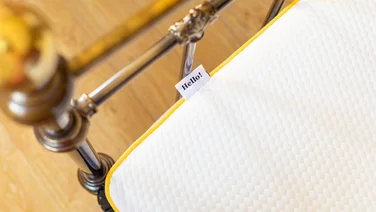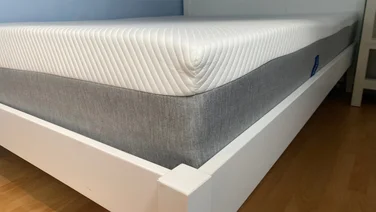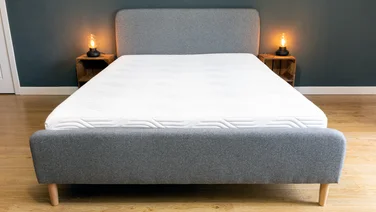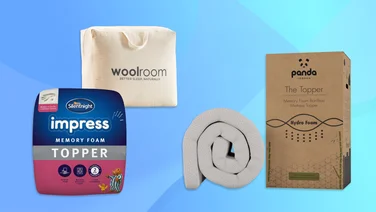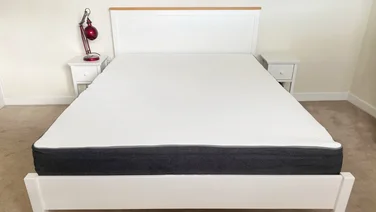To help us provide you with free impartial advice, we may earn a commission if you buy through links on our site. Learn more
- How often should I clean my mattress?
- How to clean a mattress: Step by step
- Step 1: Gather your supplies
- Step 2: Strip the bed
- Step 3: Tackle stains
- Step 4: Vacuum
- Step 5: Tackle lingering smells
- Step 6: Protect your mattress
- The dos and don’ts of mattress cleaning
- Can I pay someone to clean my mattress?
- How much does it cost?

Did you know that you spend somewhere around a third of your life lying on a mattress? Maybe you did. But how often do you think about the dust mites and bacteria – not to mention the mould, mildew and other allergens – that could be living in your mattress? We’re guessing that the answer to that is “as little as possible”.
Suffice to say, even the best mattresses have a hard life, and will steadily accumulate an unpleasant concoction of dried sweat, blood and other bodily fluids over the years – as well as oils, grime, and chemicals from cosmetic products. Happily, it doesn’t take that long to make your mattress hygienic again, and there are numerous benefits to be had as a result of doing so. You’re likely to sleep better for one, and allergy sufferers will be able to breathe more easily too.
Below, we give you the lowdown on how to clean your mattress regularly, swiftly and effectively.
How often should I clean my mattress?
Plenty of people only clean their mattresses when a spill or some other mishap forces them to act fast. (We get it – life is busy.) But regardless of whether there’s been a recent mishap, regularly cleaning your mattress is strongly advised.
A mattress can be home to between 100,000 and 10 million tiny dust mites. If you suffer from asthma or allergies, then you might want to clean your mattress on a monthly basis in order to keep those pests at bay. Chances are, your symptoms (dry eyes, streaming nose and so on) may be a clue that it’s a job overdue. Otherwise, every few months – or at least every six months – should be fine. Note, however, that certain types of mattress are more breathable than others.
How to clean a mattress: Step by step
Step 1: Gather your supplies
Before you go anywhere near your mattress, you’ll need to make sure you have the following products:
- A vacuum cleaner, preferably with crevice and upholstery attachments (see image below)
- Washing-up liquid or an upholstery cleaning solution
- Liquid detergent
- Baking soda
- Clean cloths
- A sponge
- Cold water
- Rubber gloves

Step 2: Strip the bed
First things first: strip your bed and wash and dry your sheets, duvet and pillows, including your mattress cover and/or electric blanket if you use one.Check washing instructions on the labels and use the hottest water and dryer setting permitted to kill off dust mites – bear in mind that some items may be dry clean only. The symbols on the care label will tell you what you can and can’t do.
A memory foam mattress may have a removable, machine-washable mattress cover. If so, wash it now – but check its cleaning instructions and any warranty information carefully, as the manufacturer may not reimburse you if the cover shrinks.
Step 3: Tackle stains
Now that your mattress is bare, check for stains. There are three very common types – blood, urine and other bodily fluids including sweat. We’ve added to this a fourth, food and drink, for those who eat and drink in bed.

Blood: Pat, but don’t rub the stain with a smidge of cold water and leave to dry. Remarkably, this is often all it takes. If this doesn’t remove the stain, however, add a little baking soda to the water and try again, leaving it for half-an-hour before patting it again with clean water then leaving it to dry. If it’s still not clean? Try diluting washing-up liquid in water and dab it on the stain with a cloth.
Urine: Dilute some washing-up liquid in water and dab it on the stain with a cloth. No good? Use an upholstery cleaner such as Vanish Oxi Action Carpet Care Vacuum Up Powder 650g (~£12), but try diluting it first and spray it onto a cloth before application, as opposed to spraying directly onto the mattress.
Bodily fluids (like sweat): Use the diluted washing-up liquid method as above.
Food and drink: Use the baking soda and water method mentioned above.
Mattresses aren’t waterproof, so never drench them. Instead, dab with care and only use cleaning products after checking the care label. Even then, test any solution on a small area of the stain first to check it won’t ruin the mattress. And while the methods outlined above will help to remove ingrained stains, it’s always better to treat any right away while they’re still fresh. If that’s the situation you’re dealing with, read on.
How do I remove fresh stains?
If your bed has only just been stained, consider yourself lucky. You’ll always achieve the best results by tackling stains as quickly as possible after they’ve happened, preferably before they dry. But, as with older stains, don’t be tempted to drench your mattress: it isn’t waterproof. Always check the manufacturer’s care instructions before attempting to remove the stain, and do a spot test on part of the mattress material or stain first.
Blood: Remove as much of the excess blood as possible by dabbing it with a clean cloth soaked in cold water; hot water can set the stain. Don’t rub the stain, as this will spread it. Next, blot with a clean towel. Repeat this soak and dry method until the dry cloth comes away clean. Now you’re ready to use a cleaning solution: a little baking soda mixed in cold water, or liquid detergent mixed with water until frothy. Whichever solution you opt for, dab it on the stain and leave it in place for half-an-hour before rubbing it with a clean toothbrush. Finally, dab with a fresh cloth with cold water to remove any excess cleaner or leftover blood. Then allow the fabric to air dry.
Urine: First, blot up as much of the urine as possible, using a sponge. If the sponge becomes soaked, wring it out and repeat. Slightly dampen the area – do not saturate it – to dilute the urine. Allow it to dry. If any of the stain or smell remains, follow the instructions for more entrenched urine stains in the section above.
Food and drink: If you’ve had a minor accident, such as spilling a cup of tea in bed, dilute some washing up liquid in water and gently dab the stain until it lifts, leaving it to dry afterwards.
Step 4: Vacuum

Once you’ve removed any stains, fix the upholstery attachment to your vacuum cleaner and run it up and down the entire surface of the mattress. We’re fond of the AEG QX9 (~£200) for this – it’s super lightweight and surprisingly powerful for its size, and it can be used as a handheld vacuum as well as a stick.
Repeat the process a number of times, being sure to collect up all the dust and dead skin by overlapping in neat, straight lines right up to the edges of the mattress and including the sides too. Then use the crevice tool to reach into the quilting and along the edges. Turn over your mattress and vacuum the other side too. Now let it breathe, ideally with the window open (or better still, outside if it’s a sunny day), and vacuum all around the floor, including under the bed.
Step 5: Tackle lingering smells
We’re not always aware of our own body smells, but there’s nothing worse than the smell of stale sweat that’s built up over time. The process we’ve already been through, of washing all bedding and bed linen, removing stains, vacuuming and airing the mattress, should get rid of the odour. But if it hasn’t – or this is the first time you’ve cleaned your mattress in a long time – it’s worth deodorising it by sprinkling baking soda all over the mattress. This process slowly brings all the moisture and body oils to the very top of the mattress. After a few hours, or even overnight, vacuum and air it again.
Step 6: Protect your mattress
Use a mattress protector, which goes between the mattress and your sheet to help prevent liquids and dead skin reaching your mattress. While you don’t need to wash your protector as often as you wash your bedding, it’s good practice to do so every couple of months (most mattress protectors are machine washable). If you don’t have one, Nectar’s mattress protector is our top pick of the best mattress protectors we’ve tested.
Beyond this, always treat stains as quickly as you can, and turn or rotate your mattress as recommended by the manufacturer. (Note that not all mattresses can be flipped.)
The dos and don’ts of mattress cleaning
Do:
Clean your mattress regularly, at least every six months.
Tackle stains immediately – or as soon as possible after they’ve happened.
Always check the care instructions on your mattress’ care label before cleaning.
Spot test any cleaning solution on a small area of your mattress before using it on the full stain or surface, to ensure it won’t spoil the mattress.
Remember: mattresses don’t tend to last more than 10 years – and that’s the really good ones. A time will come when you have to dispose of your mattress, not just clean it.
Don’t:
Drench your mattress – it isn’t waterproof.
Use any cleaning products until you’ve checked the mattress’ care label.
Spray liquids directly onto your mattress. Spray onto a cloth and dab the mattress instead.
Use deodorising sprays – these simply mask unwelcome odours.
Get foam mattresses even the slightest bit wet. If you need to clean one with liquid, dab on only the tiniest amount.
Can I pay someone to clean my mattress?

If you can’t face the task of cleaning your mattress, whether you don’t have the time or the situation has simply become unmanageable, you can hire a professional to do it for you. There are plenty of cleaning companies that tackle mattresses as well as carpets and upholstery, and it’s usually just a question of hopping onto Google to find a nearby service.
How much does it cost?
This can vary: depending on the size of your mattress, a professional clean could cost between £20 and £80. A double mattress, for instance, costs around £42 on average to clean (according to Checkatrade). Many cleaners will offer a choice of steam cleaning or dry cleaning. The former can be a very effective method of deep cleaning a mattress, but it should NOT be used on memory foam.


